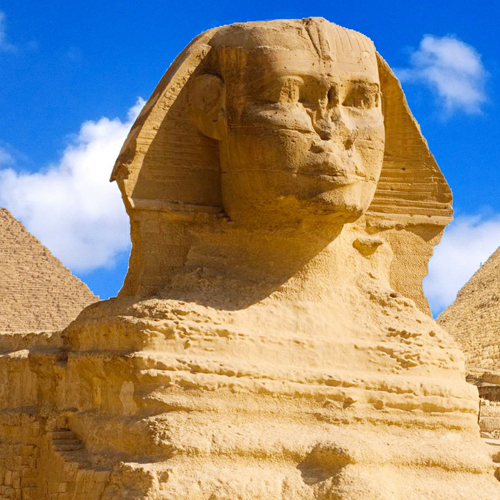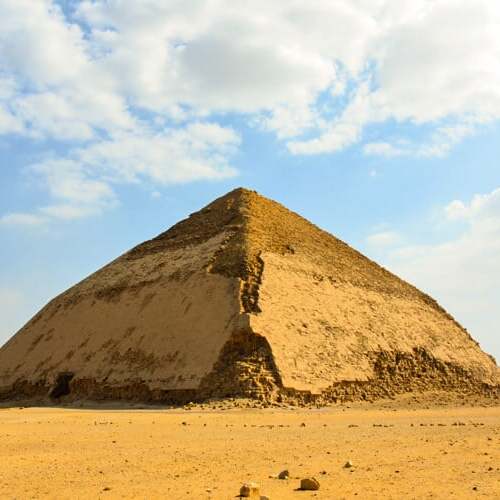No other nation in the world says ‘Welcome’ as often as the Egyptians, and every time, they mean it. While the ancient civilization of Egypt continues to amaze, contemporary Egyptians are equally remarkable.
The Bent Pyramid
The Enigmatic Beauty of the Bent Pyramid: Snefru's Architectural Ambition
In the annals of ancient Egypt‘s pyramid construction, a chapter of innovation and grand ambition unfolds, centered around the enigmatic figure of Pharaoh Snefru, a luminary of the Fourth Dynasty. This visionary monarch, whose son Khufu would later etch his name in history with the Great Pyramid of Giza, embarked on a remarkable pyramid-building journey that culminated in the creation of an architectural wonder, the renowned Bent Pyramid.
Snefru’s fascination with pyramid construction ignited when he set out to erect a monument in Meidum to honor the memory of his beloved father, Pharaoh Huni. Historical records indicate that the construction at Meidum was eventually halted, and the pharaoh redirected his workforce to the arid expanses of Dahshur. Here, in the heart of the desert, Snefru issued a resolute command: the construction of a new pyramid, a tribute to his reign and a testament to his vision. This pyramid bore the name “Snefru Shines in the South,” though history has bestowed upon it the moniker, the “Bent Pyramid,” due to its distinctive and unusual shape.
Nestled upon the desert plateau, a mere 3 kilometers west of Dahshur, the Bent Pyramid beckons explorers and travelers alike with its enigmatic allure. Snefru harbored grand aspirations for his second pyramid, setting out to create the grandest Egyptian pyramid ever conceived. The initial dimensions were staggering—a colossal base length of approximately 189 meters and an imposing height of 105 meters. However, as the pyramid took shape, the architects faced unforeseen challenges. The steep slopes they had designed proved too daunting to navigate, compelling them to alter the pyramid’s incline midway. This, in turn, led to a reduction in height and the volume of stones employed in the upper sections. In essence, the architects were engaged in a groundbreaking experiment, learning and adapting as they crafted this monumental structure.
Throughout the ages, scholars and Egyptologists have theorized about the reasons behind these alterations. One hypothesis postulates that the foundation beneath the pyramid was unstable, necessitating a reduction in weight atop the structure to prevent potential internal chamber collapse. Alternatively, it is suggested that political or religious motivations may have driven the unique angular adjustment, resulting in the distinctive bent shape that we behold today.
What sets the Bent Pyramid apart, aside from its unique shape, are its dual entrances, offering an intriguing puzzle for those who seek to understand its mysteries. The northern entrance, positioned 12 meters above ground level, and the western entrance, an astonishing 30 meters higher than the pyramid’s base, have sparked countless debates. Some speculate that part of the pyramid may have experienced a collapse, leading architects to seal off one entrance as a safety precaution.
Adjacent to the southern side of the Bent Pyramid lies a smaller cult pyramid, encased within colossal enclosure walls hewn from golden-hued limestone. Within the confines of this satellite pyramid stands a diminutive cult chapel, adorned with two stelae, each inscribed with the titles and names of esteemed Egyptian pharaohs.
A limestone causeway stretches from the enclosure’s northeast corner to the rectangular valley temple, an architectural marvel that was curiously positioned outside the Nile valley.
The presence of homes for mortuary priests, situated between a massive mudbrick wall and the valley temple, bears witness to the enduring legacy of the mortuary cult, underscoring the notion that Snefru’s influence transcended his era, echoing through the annals of the Middle Kingdom.
The Bent Pyramid, with its enigmatic shape and rich history, stands as a testament to the audacity of Snefru’s architectural ambition, a resounding testament to the ingenuity and adaptability of ancient Egyptian builders, and an enduring enigma awaiting those who venture to explore its secrets.
Created On March 18, 2020
Updated On Aug , 2024
Giza Travel Guide



